|
The Pioneer - the man who leads
the way. Pioneers those groups of far-sighted, tough, skilled
and undeterable worker-adventurers who go ahead to prepare
the way for others. For a new civilization, for an advancing
army. These are the accepted definitions of the Pioneers of
old. Within the British Army the Royal Pioneer Corps had a
similar tough spirit, far sighted outlook and widely embracing
purpose. The
idea of having a fighting soldier whose chief role was providing
labour is not a new one. One of the earliest references may
perhaps be found in the book of Nehemiah, chapter 4, verse
17 :-
They which
build on the wall, and they that bare burdens, with those
that laded, everyone with one of his hands wrought in the
work, and with the other hand held a weapon.
Mention is made of Pioneers in the
pay and muster role of the British Garrison at Calais in the
year 1346. In 1600 Pioneer contingents under their own Officers
and NCOs were attached to the Artillery and later, a company
of Pioneers served with the 7th of Foot (Royal Fusiliers).
By 1739 the Guards had organised and maintained a detachment,
followed by the Black Watch and many other Infantry Regiments.
An old record of dress regulations for Pioneers laid down
that :-
'The
cap shall be embroidered shovel in front' a
device which was incorporated on the cap badge in 1984.
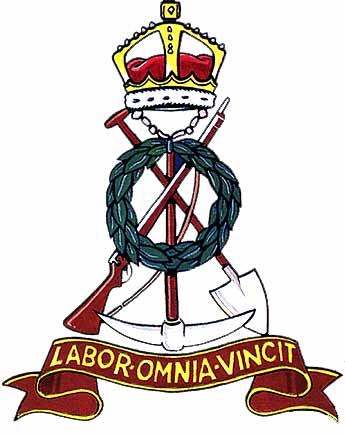
• The initial
cap badge
About 1750 a proposal was put forward
for a Corps of Pioneers with their own Regimental organisation.
An interesting point about this proposition was in its reference
to dress, which stated that the service uniform was to be
:-
'Not
to glaring to be seen at a distance nor one
that is soon soiled or dirtied when on work in the field.'
Nothing was done about the formation
of a separate Corps, except that during the siege of Gibraltar
1779-1783 an independent Corps, based on the previous plans,
actually served on the rock. From a series of Regimental records
kept with the War Office papers at the public record office
it has been established that a Corps of Military Labourers
was raised for labour duties in tropical colonies on 25 August
1817. It was made up from supernumerary rank and file of the
1st, 3rd and 6th West Indian Regiments. The Corps had no officers
of its own, but was administered by the local staff Officers
of the Quartermasters General department.The
Company established consisted of 5 Sergeants, 5 Corporals
and 100 Privates. The senior NCOs were usually white, the
remainder being coloured men. The initial duty stations of
the Corps were: Barbados five companies, Barbuda, Tobago,
St Lucia, Dominica, Granada, Demerera, Trinidad, St Vincent,
Antigua and St Kitts each having on Company. It is believed
that this Corps was disbanded on 1st October 1888.
During the Crimean War 1854-56 the
Army Works Corp came into being. Raised in the summer
of 1855 it initially consisted of 1000 men, most of them Navvies
and Artificers. They were commanded and supervised by an efficient
staff of Officers and Foremen, elected from the principal
public works organisations in the United Kingdom. The first
detachment of the Army Works Corps arrived in the Crimea on
11 August 1855 and the last in the middle of September of
that year. The object for forming the Corps was
'The
carrying out of works of a civil character at the Seat of
War such as the construction of Roads and Railways, the
erection of stonehouses and jetties, on which stores and
materials might be landed with facility.
The next reference to Pioneers that
can be readily established is that of the 106th Hazara
Pioneers of the Indian Army. Much of the Indian Army's
work was done in roadless country and there was a steady demand
for battalions of Pioneers Many were raised at various times
but few of them had a long career. The usual practice was
to raise them in a hurry when they were needed and disband
them as soon as the immediate emergency was over. The Hazara
Pioneers had a longer run than most. They were raised in 1904
and disbanded in a burst of economy in 1933. During their
short life they were given the number belonging to the 6th
Bombay Infantry, which had been disbanded in the economies
of 1882. The uniform was drab with red facings until 1914,
at which time full dress almost ceased to be worn. Then it
was changed to scarlet with plum facings.
In August 1914 there was no formed body of troops specifically designed for these tasks. In the infantry, manual work near the front lines was carried out by the Pioneer Battalions which were added to each Division. Some infantry regiments formed labour companies and works battalions for work on the lines of communication and at home, but the organisation of manpower was haphazard until the formation of the Labour Corps.
The labour units expanded hugely and became increasingly well-organised. However, despite adding large numbers of men from India, Egypt, China and elsewhere, there was never enough manpower to do all the labouring work required. The total number of men engaged on work in France and Flanders alone approximated 700,000 at the end of the war, and this was in the labour units alone. In many cases the men of the infantry, artillery and other arms were forced to give up time to hard effort when perhaps training or rest might have been a more effective option.
According to the Official History: "..although some labour units were raised and eventually labourers from various parts of the Empire and China were brought to France, the numbers were never at any period sufficient for the demands of a great army operating in a friendly country".
BEFORE THE FORMATION OF THE LABOUR CORPS
The Army Service Corps Labour Companies
Among the earliest such units formed, the ASC Labour Companies originated to provide manpower to unload British ships and operate the docks in France. Two railway labour companies were also formed.
The Royal Engineers Labour Battalions
The RE raised 11 Battalions for labouring work.
Infantry Pioneer and Labour or Works Battalions
An early solution to the vast demand for labour was to create in each infantry Division a battalion that would be trained and capable of fighting as infantry, but that would normally be engaged on labouring work. They were given the name of Pioneers. They differed from normal infantry in that they would be composed of a mixture of men who were experienced with picks and shovels (i.e. miners, road men, etc) and some who had skilled trades (smiths, carpenters, joiners, bricklayers, masons, tinsmiths, engine drivers and fitters). A Pioneer battalion would also carry a range of technical stores that infantry would not. This type of battalion came into being with an Army Order in December 1914. In early 1916, a number of infantry battalions composed of men who were medically graded unfit for the fighting were formed for labouring work. They had only 2 officers per battalion. Twelve such battalions existed in June 1916.
Non Combatant Corps
After the passing of the Military Service Act in early 1916 it was decided to form a Non-Combatant Corps of conscientious objectors for work on roads, hutments, timber work, quarrying, sanitary duties and handling supplies. Eight NCC Companies existed by the middle of June 1916.
THE LABOUR CORPS
Formed in
February 1917, is generally regarded as a predecessor of the
Royal Pioneer Corps. In WW1 the British had no organised Labour system at the start
of the war, depending on civilians supplied by the French
Government. As the war progressed demands for Labour increased
as armies grew in size and at the same time less Frenchmen
available to assist. The British started to send labourers
to France in 1915-1916 to work in docks etc. In April 1917
they were formed into a Labour Corps which was to reach 325,000
British soldiers, 98,000 Chinese, 10,000 Africans, 6 Battalions
British West Indies Regt, 300,000 PWs and contingents from
Egypt and Fiji all serving in France in Nov 1918. They also
included non-combatant Coys and Alien Coys. Among its ranks
were a number of labour units, originally formed as Battalions
of Infantry Regiments. These were of two types, Works Battalions
and Labour Battalions. When these were transferred from the
infantry to the Labour Corps in the middle of 1917, the Works
Battalions were (rather confusingly) re-designated Labour
Battalions, while the original Labour Battalions were broken
up and reformed as Independent Labour Companies.
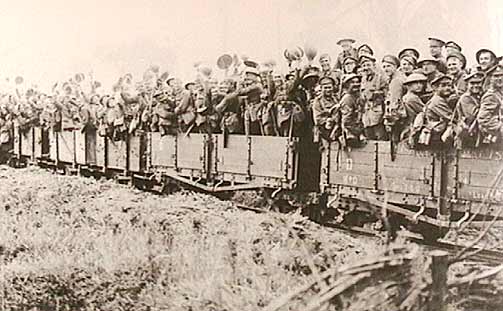
• Pioneers of the 11/DLI on
a light railway at Elverdinghe on the opening day of Third
Ypres.
The initial need for labour units during
WW1 had been achieved with some 38 Labour Battalions established
in 18 different infantry regiments, and a large number of
Labour Companies from other infantry regiments. In addition
there were a good number of Labour Companies in the Royal
Engineers and the Army Service Corps. All these became Labour
Corps companies in the spring and summer of 1917. The Labour
Battalions and later the Labour Companies of the Labour Corps
carried out a whole range of defence works duties in the UK
and in overseas theatres, especially in France and Flanders.
These included road and railway building/repair, moving ammunition
and stores, load and unloading ships and trains, burial duties
and at home agriculture and forestry.
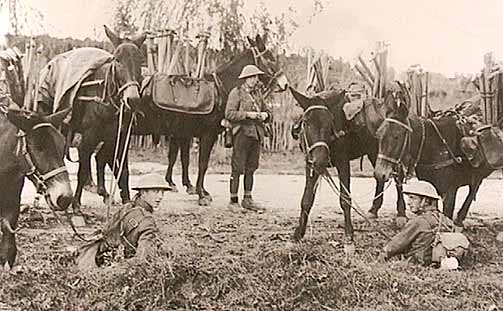
• Pioneers and RE used a variety
of means to transport tools and stores.
These mules are equipped with saddles designed to carry two
dozen shovels.
Aveluy Wood, September 1916.
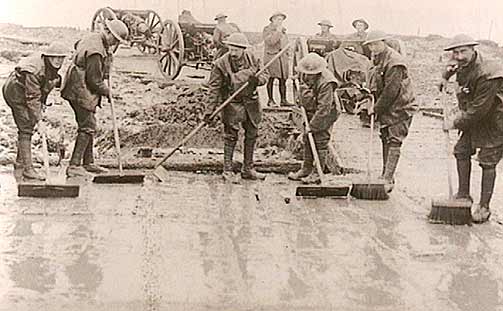
• A regular feature of a Pioneer's
life was road clearing.
Men using scoopes to sweep mud from a road near St. Julien
during Third Ypres.
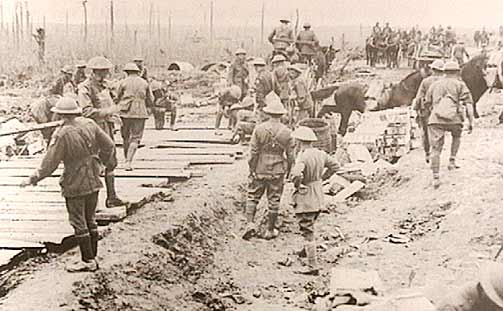
• Typical of the many plank
roads laid across the slough beneath the Passchendaele
ridge. This photo shows men of an Australian Pioneer battalion
laying a road
near Chateau Wood in September 1917.
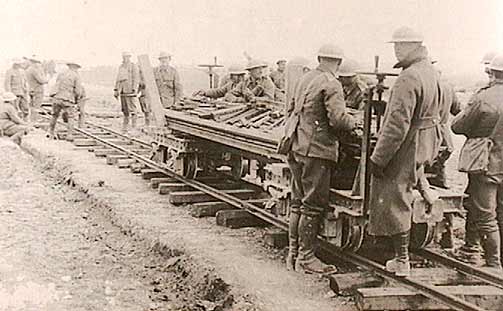
• Light railways were pushed
across captured ground as soon as prevailing
conditions allowed. Pioneers were frequently employed in laying
and running
such lines. This track was constructed near Feuchy during
the Arras offensive of 1917.
|
When the Labour Corps was formed in
mid 1917 it was decided that the men assigned to it from other
regiments, often because of their reduced medical category,
should change their regimental badges to that of the
General Service Corps. Many of the men disliked having
to wear this badge and preferred to retain their regimental
identity. Towards the end of 1918 the Labour Corps was granted
their own badge - the piled pick, rifle and shovel emblem
that was to become the badge of the Pioneer Corps (later
Royal Pioneer Corps). Once it had been created, the Labour
Corps was split into various Labour groups, each consisting
of a headquarters and several Labour companies. In addition
there were Area Employment Companies, Area Employment (Artisan)
Companies, Divisional Employment Companies, and Agricultural
Companies.
Special Labour units were not fully
mobile and were limited to a geographical area. They were
called Employment Companies. They were identified by another
prefix - Area, Divisional, Corps or Army. Area Coys were located
in a specific town undertaking the routine tasks etc and they
never moved. Divisional and Corps Companies were attached
to the relevant Headquarters and moved with that unit. They
were only employed in the unit and consisted of lower graded
men who were physically less capable to the standard Labour
Companies. The personnel included, clerks, batmen, runners,
cooks in messes, Divisional Concert Party, sock depot, laundry
and bath units and also supplied men to the sanitary and salvage
sections. These men were working in the units prior to the
formation of the Labour Corps and had no organised establishment
or chain of command so they were all transferred under the
Labour Corps.
The company establishment was two officers,
one company Quarter Master Sergeant, 270 NCOs and Privates,
an Orderly Room Clerk and a Batman. Normal Labour companies
were commanded by a Major and consisted of some 425 men. The
company role was a varied one including running the divisional
baths, laundry, cinema, stores and officers mess as well as
acting as divisional police and undertaking guard duty. Within
the company there were specialists such as tailors, shoemakers,
butchers and telephone operators.
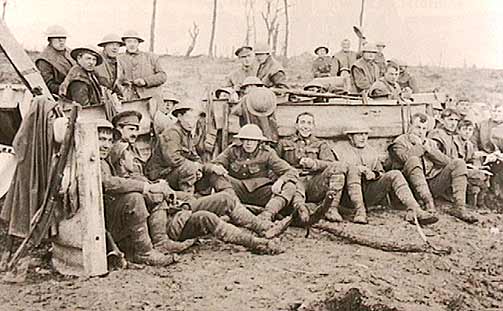
• Men of the 22/Durham Light
Infantry Pioneer battalion pose for the
camera during a break from their labours near Maurepas in
December 1916.

• Pioneers of the 11/Liverpool
enjoying an alfresco meal in exposed
conditions near Ypres in December 1917. Note the regimental
badge on some helmets.
Although initially considered non-combatants,
the British companies of the Labour Corps often performed
their duties in forward areas, often under heavy fire. In
the spring of 1918 the Corps assumed combatant status for
dealing with the last German offensive of March 1918. Throughout
the summer of that year the men of the Labour Corps units
in the forward areas worked fully armed and some served as
fighting soldiers when need arose. However the vast majority
of men continued to work in unarmed companies. Life in the
Labour Corps could be as bad as that enjoyed by front line
troops; they were often under continual shellfire for months
at a time. Indeed 2,300 men in the Labour Corps were either
killed in action or died of wounds between May 1917 and the
end of the war.
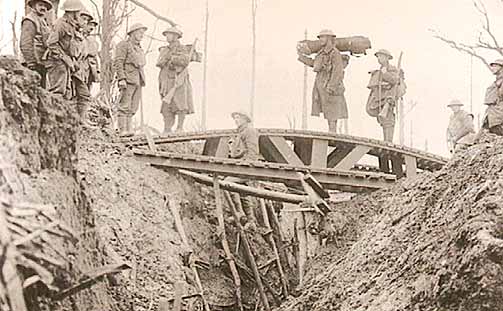
• Constructing and erecting
trench bridges were frequent tasks for the Pioneer battalions.
This is a standard trench bridge crossing former German trenches
at Gommecourt.
Pioneer battalions, created
as an expedient in 1914, were a new concept in the British
Army. Intended to provide the Royal Engineers with skilled
labour and to relieve the infantry from some of its non-combatant
duties, Pioneers became the work horses of the Expeditionary
Forces. The Coldstream Guards and over three dozen County
regiments, each created at least one pioneer battalion. Several
new Army battalions were raised specifically as Pioneers,
while others were converted Territorials or Kitchener units
formed originally as conventional infantry. Adopting a badge
of a cross rifle and pick, these battalions wired, dug and
revetted in all weathers and in all terrains. On many occasions
they abandoned their working tools and fought alongside the
infantry in repelling enemy attacks. In their efforts to stem
the German offensives of 1918, several Pioneer units fought
themselves to virtual annihilation. The work of the Pioneer
battalions has been largely ignored or misunderstood. Far
from being the units of the aged and infirm, these sixty eight
battalions played a major role in the Allied victory.
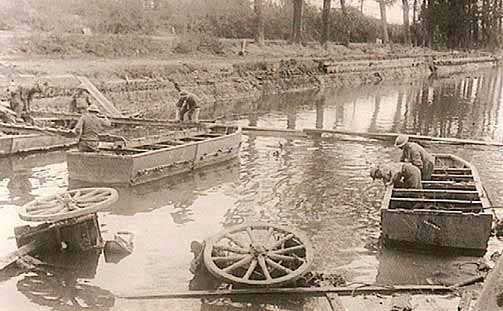
• Pioneers of the 10/DCLI constructing
a pontoon
bridge over the canalised River Scheldt in October 1918.
Indian, Chinese, native South African, Egyptian and other overseas labour
With the shortage of manpower for labouring work continuing, Sir Douglas Haig requested an increase in the force of an additional 21,000 men. This demand was filled by importing men from China (where the British followed a French lead and signed an agreement with the Chinese for a supply of men), India, South Africa, Egypt and other places within the British Empire. Many of them were
shipped to France via the west coast of British Columbia,
Canada. The foreign units of the Labour Corps, including the
prisoners of war, were not supposed to be posted near the
front line. However, there are many war graves in France and
Flanders that bear Chinese lettering, the resting place of
Labour Corps workers, mostly killed by shellfire. When the
war ended in November 1918, the Labour Corps continued their
support role and were also involved in salvage work, grave
and burial registration and as Prisoner of War guards.
Demand continued and by the wars end a total of approximately 300,000 such workers had been engaged, of which 193,500 were in France and Flanders. By the end of 1917 there were 50,000 Chinese workers in France, rising to 96,000 by August 1918 (with another 30,000 working for the French). 100,000 Egyptians were working in France and the Middle East, alongside 21,000 Indians and 20,000 South Africans, who were also in East Africa. They were kept on lines of communication and other work well behind the fighting line, and as a force were rather immobile due to the decisions to segregate them - many of these workers were black - and provide special camps. Indian labourers were more often used closer to the front lines, on fortification work. Many Indians were also used in Divisional Ammunition Column work, as drivers as well as in the manual tasks. The South African Native Labour Corps came to France early in 1917 and established a base at Arques-la-Bataille.
Women's Auxiliary Army Corps
Formed in March 1917 after a proposal by the Army Council was welcomed by Sir Douglas Haig. Women would be used on the Lines of Communication and at GHQ, on tasks that did not require heavy labour. Initially called the Women's Army Auxiliary Corps (WAACs), they eventually took the formal title of Queen Mary's Army Auxiliary Corps. The women enlisted for a year or duration, whichever was longer. They were used on a wide variety of tasks, principally in clerical, canteen, motor transport, storehouses and telephone and postal roles. Approximately 10,000 WAACs saw service, most in France and Flanders. More information
Entrenching Battalions
Formed from the small surplus of men left after the break-up of many infantry battalions in early 1918, and the re-allocation of their strength to bring other units up to establishment. Men were all regarded as fit and ready to replace losses in fighting units at any time. There is some evidence that some Entrenching units were also formed in 1916. More information
Use of enemy prisoners of war
Until mid 1916, German prisoners were sent to England. From this time onward, prisoners were initially sent to Abbeville. Men with useful skills, notably forestry and engineering, were drafted into companies of about 100 men each, for use in POW Forestry Companies and ASC and RE workshops, respectively. 47 such POW labour companies were attached to the Labour Corps when it was formed.
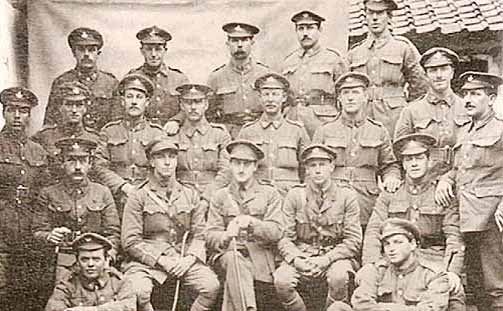
• After a gruelling period on
the Somme, the concert party of the 11/DLI posed for
this picture at Picquigny in October 1916. Captain G S Fillingham
(centre) was
posted from the regular 2/DLI. He recalled:
'A typical pioneer job
was this - be present under shell fire all day in support
of the main attack.
Then move forward and grab ground and dig trenches in so called
no man's land under enemy
fire at night. Go back before day break, sleep and start all
over again. Casualties no object'.
By the end of the war the Labour Corps
had a strength of about 380,000 men stationed in the UK, in
France and Flanders, Italy, Egypt and Salonika. In fact the
size of the Corps reached its greatest of almost 400,000 in
Jan 1919. This included about 240 Labour Companies in France
and Flanders with about thirty to fifty Labour Companies allocated
to each of the first, second, third, fourth and fifth armies,
with a few kept aside as lines of communication units. There
were about the same number of companies serving elsewhere
overseas at area, divisional, corps and army level as well
as some 400 or so companies working in the UK. In late 1918
and early 1919 there were Labour Companies numbered from 1
to over 1000, with little evidence of their origin. The Labour
Corps was disbanded late in 1919.
In 1937, as part of the general planning
for war provision was made for a special labour force to consist
of Infantry and Cavalry reservists to be formed in groups
and companies under the general administration of the Royal
Engineers. Some of these formations landed in France within
the first weeks of World War 2 in September 1939.
In WW2 the Labour Corps was reformed
but due to the association with Labour it was named Auxiliary
Military Pioneer Corps on 17 October 1939 out of the six
group headquarters and 48 companies then existing, who had
been sent to France with the BEF in the first week of the
war. The units were the same as the Labour Companies in WW1
but no Employment Companies were formed as the HQ had their
own establishment and personnel working within depots etc
were drawn from Pioneer Companies. Direct enlistment into
the Corps began that day. In December 1939 a Director of Auxiliary
Pioneer Services was appointed who worked under the Director
of Recruiting and Organisation. Enemy Aliens were recruited
into the Pioneer Corps and over 10,000 Germans, Austrians
and Italians were recruited. Some fought in BEF in 1939, 1940.
They served in Alien Companies but by 1942 when their loyalty
was confirmed many were allowed to transfer to the Fighting
Arms (No 10 Command and the 2 Pathfinder Parachute Companies)
were all Germans. Many were commissioned into all three services.
In November 1939 the War Office approved a badge for the Corps. Described as:- A rifle, a shovel and a pick ‘piled’ on them a laurel wreath, all ensigned with a crown. Beneath, the motto Labor Omnia Vincit (Work Conquers all). The badge was not designed for the Pioneer Corps but was approved in October 1918 for the Labour Corps which was formed in 1917 and disbanded in 1919.
In July 1940 a Brigadier was appointed
as Inspector, Auxiliary Military Pioneer Corps. In August
1940 the Quartermaster General proposed that a Labour Directorate
should be formed under his department. The existing appointments
were abolished. Brigadier ALI Friend, who had been inspector
of the AMPC was appointed Director and Inspector of Labour
with a staff of a 1 ADL, 1 DADL and 2 Staff Captains. The
Corps rapidly expanded as the Services' need for a larger
labour force became apparent. The title was changed to Pioneer
Corps in 1940.
In November 1940 the Colonel Commandant,
Field Marshall Lord Milne, pointed out that the title Auxiliary
Military Pioneer Corps was extremely unpopular with all ranks
and bad for esperite de corps. At the same time it was agreed
that Companies should be armed on 100% scale instead of 25%
which has previously been the case. Training centres were
quickly formed to receive, clothe and equip recruits and personnel
posted from other Arms Companies were formed and dispatched
as required, this being the normal unit allotted to meet labour
requirements. It was usually to consist of about 280 men divided
into 10 sections of 26 men and a small HQ. Each section was
commanded by a Sgt. Two sections were commanded by a Lieutenant.
A number of companies (between 4 and 20) within a geographical
area would be commanded by a Group HQ under a Lieutenant Colonel.
In addition to UK troops, Pioneers
were enlisted from the Commonwealth and included Swazis, Basutos,
Buchuanas, East and West Africans, Mauritians, Rodriguais
and Seychellois, Sinhalese, Indians of all classes, Cypriots
and Maltese. Syrians, Palestines and Arabs also joined the
Corps. In addition, in NW Europe, Free French, Dutch and Belgian
Companies of Pioneers were formed.
Worldwide, wherever labour was required
to keep the military machine in operation, including control
and administration of civilian labour in support of the Forces,
Pioneers played their part with distinction. When called upon
the Corps took its place alongside the infantry - in France
etc. Wherever Pioneers served
commanders paid tribute to their work and contribution to
final victory. During the war there was practically no task
that was not performed by Pioneers. The Corps handled all
kinds and types of stores and ammunition, built camps, airfields
and fortifications, cleared rubble and demolished roadblocks,
built roads, railways and bridges, loaded and unloaded ships,
trains and planes, constructed aircraft pens against enemy
bombing and a host of other jobs.
It is true to say that there was no
British theatre of war in the world where Pioneers were not
to be found. In November 1942 Pioneers made their first amphibious
landing in North Africa with the First Army and earned a great
name during the six months campaign. One Company went into
the line as infantry for three weeks and acquitted itself
with great credit.
D-Day - The Pioneer Story
|
